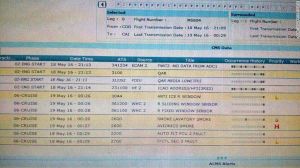
This is a screenshot of ACARS messages automatically datalinked from Egyptair flight MS804 to the airline’s operations headquarters shortly before the aircraft appeared – on radar – to go out of control.
News of the ACARS datalinked message first appeared in the Aviation Herald, a respected Salzburg, Austria-based journal that publishes on aviation safety issues. The French accident investigator BEA, which is helping Egypt with the inquiry, has confirmed the existence of the information. (ACARS = Aircraft Communications Addressing and Reporting System).
The printout/screenshot shows that all was more-or-less well in the aircraft until smoke was recorded in the forward lavatory just behind the flight deck.
A minute later smoke was recorded in the avionics bay, which is below the flightdeck floor, therefore close to the forward lavatory. The avionics bay contains all the electronic sensors and computers that provide the pilots with the information they need, and connections to the computers that direct the flight controls.
Two minutes after the smoke warning for the avionics bay the FCU 2 (second flight control unit) recorded a fault, and the SEC 3 (the N0 3 spoiler/elevator computer) also recorded a fault.
According to the Aviation Herald’s source, the ACARS feed then stopped.
Warnings about all these would have appeared on the pilots’ instrument panel.
There were other symptoms in the ACARS messages that popped up before the smoke was sensed by the system. These related to cockpit window de-icing and related window sensors, and were nothing to do with the aircraft controls but may have been yet another symptom of early fire damage to electrical systems.
The question now is whether the fire that caused the smoke was the result of an electrical fault – for example a short-circuit caused by damaged wiring – or whether some form of explosive or incendiary device was used – for example by a terrorist – to generate a fire or other damage.
The fire appears to have propagated fast. Flight control computers were failing within two minutes of the avionics bay smoke warning. If more of them failed subsequently the pilots would have limited means for controlling the aircraft, and with fire present, crew stress would have been extremely high.
That might explain the fact that there was no distress call. The pilots were trying to understand what the cause of the fire warnings was, where the source of the fire was located, whether they could do anything to stop it, and coping with a gradual degradation of their ability to control the aircraft.
These facts, providing they are not some kind of macabre coincidence, may have provided the basic reason why the aircraft went out of control and crashed.
But it is still not clear whether this situation was the result of terrorist action or an aircraft fault. Certainly no terrorist group has claimed responsibility.
And that answer is unlikely to be forthcoming soon. Even the recovery of the cockpit voice recorder and flight data recorded may not provide absolute proof of terrorist action – or lack of it – although the data will probably provide compelling circumstantial evidence.